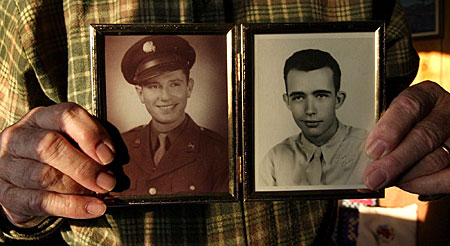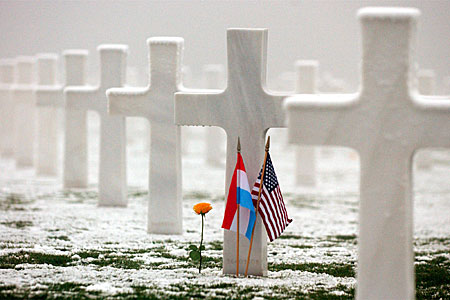
Posted on 12/19/2004 6:45:42 AM PST by csvset
60 years later, Virginia man remembers WWII massacre
By ROBERT MCCABE, The Virginian-Pilot
© December 17, 2004
Last updated: 12:23 PM
 |
| Bill Merriken was a member of Battery B of the 285th Field Artillery Observation Battalion in 1944, many of whom died in the ''Malmedy Massacre.'' Jill Nance
|
|
After herding the American prisoners into a field on Sunday afternoon, Dec. 17, 1944 , machine-gunners on German tanks opened fire.
Merriken, one of the last to enter the field and closer to the tanks, threw himself on the ground, his face buried in the crook of his left arm.
Though two machine-gun bullets tore into his back – one close to his spinal column – he remained fully conscious, frozen in position.
“I prayed that somebody in that group would survive and come out,” he recalled. “Thank God, I was one of them. I was hoping somebody was still alive that could tell the story.”
Now 82, Merriken sat recently in the remodeled basement of his four-bedroom home in Bedford and shared – as much as his memory and his emotions would allow – the horrific events of that day and what followed.
“I would like for people to know what happened, because a lot of people don’t know,” he said.
Merriken’s account of the “Malmedy Massacre,” as it became known, falls roughly halfway through “The Longest Winter,” a new book by Alex Kershaw about the Battle of the Bulge.
The book follows the publication a year ago of “The Bedford Boys,” Kershaw’s story of the members of a former Bedford-based National Guard unit that was in the first wave at Omaha Beach on D-Day, June 6, 1944. Nineteen Bedford men from that unit were killed in the first 15 minutes of the invasion.
Merriken, a graduate of Bedford High School, knew many of them.
Later that year, two more men from the Bedford area were among those killed at Malmedy.
Kershaw’s new book, about the German army’s desperate counterattack on Dec. 16, 1944, recounts how an 18-man American platoon held off the leading edge of the German assault at the Battle of the Bulge for 12 hours.
Merriken was not in that platoon but in Battery B of the 285th Field Artillery Observation Battalion, whose job was to spot enemy locations.
The day after the German attack began, Merriken’s 30-truck convoy collided with a German armored column led by SS Lt. Col. Joachim Peiper at the Baugnez crossroads, near Malmedy.
“I was in the second vehicle in the convoy,” Merriken said. “We saw shells coming into this field.”
Quickly overwhelmed by German tank and machine-gun fire, his unit soon heard the voice of a German officer in an armored vehicle shouting, “Up, up, up,” Merriken said, telling the Americans to get out of the roadside ditches into which they dove for cover, and to go to the rear.
The battery officer told his troops to surrender, because they were defenseless against an armored column, Merriken said.
The German commanders were already running behind schedule and frustrated, Kershaw said in a phone interview.
“These guys don’t stop for anybody,” he said of the delayed German SS Panzer column. “There’s a big problem with what you’re going to do with POWs.”
Soon after they were captured, the group of prisoners was directed into a field, near a cafe and a few farmhouses.
“I was one of the last to go in,” Merriken recalled. “You’re in the very front, facing the road. All of us didn’t know what was going to happen. I think most of us assumed we’d be prisoners of war.”
Another German armored vehicle approached – perhaps a half-track – from which an officer stood up, took his pistol and shot a prisoner point-blank, Merriken said.
With that, the machine guns on tanks positioned nearby opened up on everybody, starting with those in the rear ranks and methodically moving forward.
“It was over in about 15 minutes,” he recalled.
German soldiers soon moved among the bodies, kicking, poking and prodding them for signs of life. At one point, they feigned offering medical attention, he said.
“ You hurt? You hurt? ” Merriken remembers them asking.
Anyone who responded was shot or clubbed with the butt of a rifle.
One grievously wounded American, clearly in pain, moved near Merriken’s left.
“He was so delirious, he didn’t know what he was doing,” he recalled. “I whispered to him, 'Be still, be still.’”
The man, however, wound up rolling over on the back of Merriken’s legs.
He said two German soldiers walked up to them. “They stood right over us,” he said .
They fired a single pistol shot, which passed through the wounded man’s body and continued through the right knee of Merriken, who never flinched.
He does not attribute that to will power, but to the weight of the man’s body.
When the slaughter was over, more than 70 American soldiers lay dead, many with gunshot wounds to the head, inflicted at close range.

Months after the recovery of the main massacre site, more bodies were found nearby. The monument that marks the site today bears the names of more than 80 men.
Precisely how many were killed in the massacre still isn’t known with absolute certainty. One Web-based account states that more than half of the Americans assembled in the field survived.
Perhaps two hours after the shooting stopped, losing blood and weakening, Merriken somehow found the strength to get to his feet. Dragging his wounded leg, he struggled toward a woodshed, but first came across a German officer running after survivors headed for some woods.
From perhaps 10 feet away, as Merriken tried to cross a fence, the German pointed his pistol at him and attempted to fire, but the gun jammed.
Merriken kept moving.
“I don’t know why it didn’t go off. I can’t tell you that,” he said. “God was with me, I can tell you that.”
The officer continued after the larger group of survivors, perhaps a dozen men, Merriken said.
Eventually, he made it to the woodshed, where he met another American soldier, Chuck Reding, who had managed to escape the massacre unscathed.
Without food or water, in nearly zero-degree weather, the two crawled from one hiding place to another before being taken in by a Belgian farm family, who hid them in an attic.
Merriken refused to let anyone tend his wounds – a decision he believes may have helped save his life. It was so cold, his blood-soaked clothing formed a kind of frozen seal on his back wounds, preventing him from bleeding to death.
He had tried to stop the bleeding from his knee by tightening the laces on his canvas legging .
A teenage Belgian boy, riding on a bike, hid a note from Reding in the sole of his shoe.
Traversing a minefield en route, he took it to the American lines.
The note disclosed the trapped soldiers’ location, leading to Merriken’s and Reding’s eventual rescue.
A lifetime later, in May 1999, while on a trip back to Malmedy, Merriken met that boy – Emile Jamar – for the first time. Only then did he learn the story of how he was saved.
After the war, Merriken came back home to Bedford. He and his wife, Betty, were married in 1958 . After a brief stint helping to run a family plumbing business, he got a degree in business administration and eventually retired as a state auditor in 1985.
Today, the Merrikens have four daughters and eight grandchildren, all of whom live in Bedford. As Bill Merriken met with a reporter recently, some of them were busy upstairs decorating for Christmas.
Though he had occasional nightmares in the years immediately after the war, he’s not sure he’d characterize the massacre as the biggest event of his life.
“I suffered other things, too,” he said. “I don’t know how to express it.”
Reach Robert McCabe at 222-5217 or Robert.McCabe@pilotonline.com.

By the way, July 14th is Bastille Day.
 Jochen Peiper is how it's spelled on his biography "The Devils Adjutant"
Jochen Peiper is how it's spelled on his biography "The Devils Adjutant" seeing that monument must be quite powerful.
p.s. my bad... it was 1976.
It is a curved wall with all the names on it. There were flowers all along the base of the wall. The American flag flys in the center of the little park. The park is at the east edge of the town. It is maintained by the American Park Service. It was foggy and misty the day we stopped to see it. Very sad we will never forget it.
That was incredibly interesting. Good post.
A generation or two hence, September 11 will face the same oblivion.
Just damn.
No. It would depend on the criteria established for acceptance. If they want only US manufactured weapons, then testing any foreign weapon would not make sense to a logical person.
There are really two different issues here and you are mixing the two, specifically:
1. Do Lugers have a reputation for jamming, under field conditions, at a rate which is higher then most other weapons. -- I say they do. A goggle search (Luger + jamming 1,280 hits) indicates that the subject is one of common opinion and discussion. Only a fool would argue that the reputation for this does not exist.
2. Is the reputation for jamming deserved? You say it is not deserved and offer no foundation for this claim, other then you personal experience.
Fine, I'm a fool, OK?
I wouldn't carry a Luger in combat, but I still like them.
And I am part of the ignorant herd.
I thought we were talking about the use of a Luger in combat? Now you say you are against that use of this gun (for that purpose). Now I am confused. Maybe best that a fool and a member of the ignorant herd end this discussion so as to not get further confused. ;)
Disclaimer: Opinions posted on Free Republic are those of the individual posters and do not necessarily represent the opinion of Free Republic or its management. All materials posted herein are protected by copyright law and the exemption for fair use of copyrighted works.